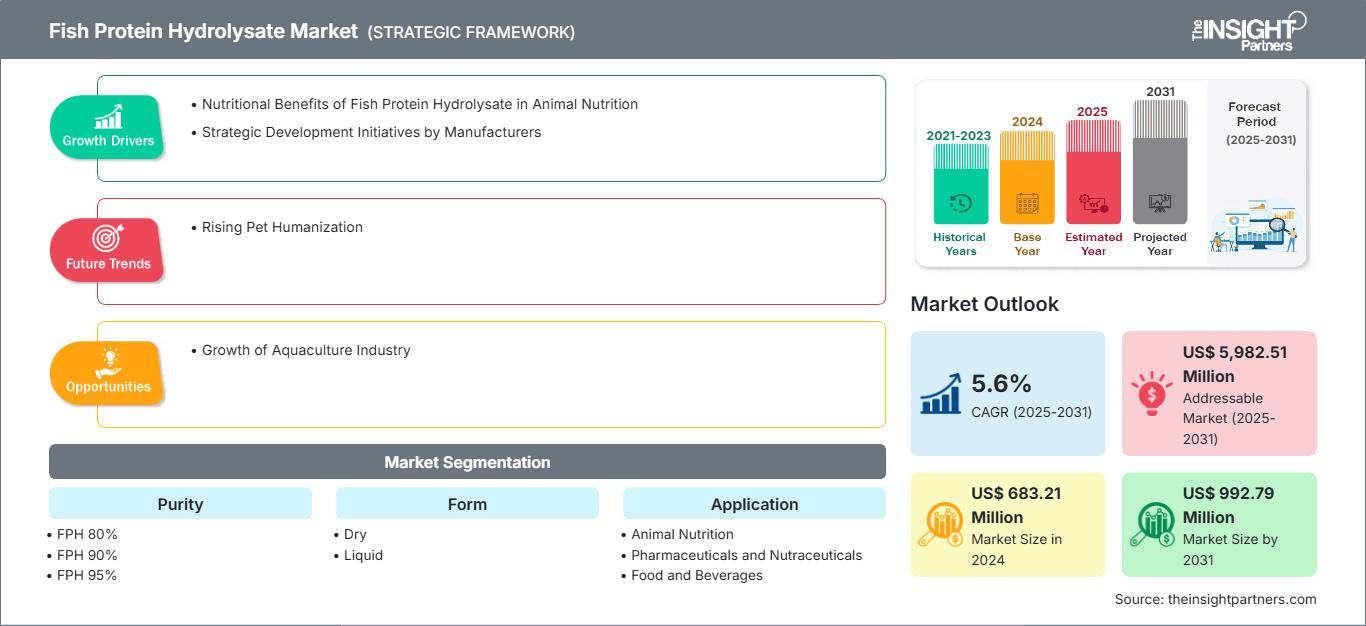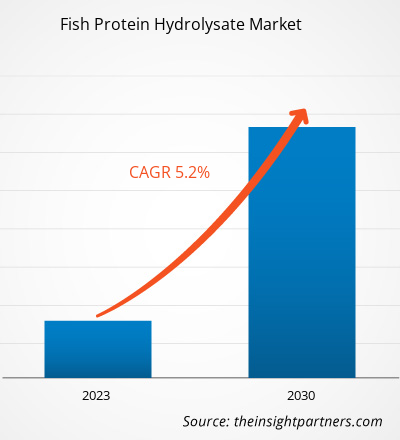Der Markt für Fischproteinhydrolysate soll von 683,21 Millionen US-Dollar im Jahr 2024 auf 992,79 Millionen US-Dollar im Jahr 2031 anwachsen. Für den Zeitraum 2025–2031 wird ein CAGR von 5,6 % erwartet. Die zunehmende Humanisierung von Haustieren dürfte im Prognosezeitraum einen neuen Trend auf dem Markt für Fischproteinhydrolysate auslösen.
Marktanalyse für Fischproteinhydrolysate
Der Markt für Fischproteinhydrolysate wird von seinen vorteilhaften Eigenschaften in der Tierernährung und verschiedenen strategischen Entwicklungen wichtiger Akteure angetrieben. Aufgrund des gestiegenen Bewusstseins für die ernährungsphysiologischen Vorteile tierischer Proteine in der Tiernahrung besteht eine steigende Nachfrage nach Fischproteinhydrolysaten (FPH) seitens der Tierfutterindustrie. Darüber hinaus treibt die wachsende Aquakulturindustrie aufgrund der gestiegenen Nachfrage nach Fisch und Meeresfrüchten auch den Bedarf an Fischproteinhydrolysaten voran. Da eine große Anzahl von Fischen jährlich große Mengen Abfall produziert, werden diese Abfälle verarbeitet und zur Herstellung von Fischproteinhydrolysaten verwendet, was das globale Marktwachstum vorantreibt.
Marktübersicht für Fischproteinhydrolysate
Fischproteinhydrolysate sind ein nährstoffreiches Produkt, das durch enzymatische oder chemische Zerlegung von Fischproteinen in kleinere Peptide und Aminosäuren gewonnen wird. Dadurch werden die Verdaulichkeit und Bioverfügbarkeit für den Einsatz in Aquakulturfutter, Tiernahrung und der Landwirtschaft verbessert. Die steigende Nachfrage nach nachhaltigen Proteinquellen, das Wachstum in der Aquakultur- und Viehwirtschaft sowie das zunehmende Bewusstsein für die ernährungsphysiologischen Vorteile von FPH treiben das Marktwachstum voran. Darüber hinaus treiben Fortschritte in der Hydrolysetechnologie und die staatliche Förderung umweltfreundlicher Alternativen das Marktwachstum weiter voran.
Passen Sie diesen Bericht Ihren Anforderungen an
Sie erhalten kostenlos Anpassungen an jedem Bericht, einschließlich Teilen dieses Berichts oder einer Analyse auf Länderebene, eines Excel-Datenpakets sowie tolle Angebote und Rabatte für Start-ups und Universitäten.
Markt für Fischproteinhydrolysate: Strategische Einblicke

-
Holen Sie sich die wichtigsten Markttrends aus diesem Bericht.Dieses KOSTENLOSE Beispiel umfasst Datenanalysen, die von Markttrends bis hin zu Schätzungen und Prognosen reichen.
Markttreiber und -chancen für Fischproteinhydrolysat
Nährwertvorteile von Fischproteinhydrolysat in der Tierernährung
FPH ist eine hervorragende Quelle für Proteine und Nährstoffe wie Phosphor, Kalzium und andere Mineralien. Es beugt aktiv der Ausbreitung von Infektionskrankheiten bei Tieren vor und stärkt deren Immunität gegen Pilze, Viren, Bakterien und Parasiten. Regelmäßiger Verzehr von FPH fördert den Muskelaufbau bei Masthühnern. Die im Fischproteinhydrolysat enthaltenen Enzyme unterstützen die Darmmorphologie von Masthühnern, indem sie die Verdauung von faserigem Futter, einschließlich Getreide und Sojamehl, erleichtern.
Darüber hinaus werden Fischproteinhydrolysate aufgrund ihres hohen Proteingehalts und der idealen Aminosäurebalance für Wassertiere häufig in Aquakulturfuttermitteln verwendet. FPHs können auch den Stoffwechsel von Tieren verbessern, wodurch das Risiko von Infektionen und Krankheiten verringert wird. In jüngster Zeit haben Verarbeitungstechnologien zudem die Produktion von qualitativ hochwertigeren und konsistenteren FPH-Zutaten ermöglicht. Laut einem Bericht des Food Engineering Magazine aus dem Jahr 2023 treiben Fortschritte bei der enzymatischen Hydrolyse und der nachhaltigen Gewinnung von Fischnebenprodukten die Skalierbarkeit von FPH in kommerziellen Futtermittelanwendungen voran. Wichtige Marktteilnehmer nutzen diese technologischen Innovationen zunehmend, um die steigende Nachfrage nach Clean-Label-Funktionsfutterzutaten für Tiere zu bedienen. Daher tragen die ernährungsphysiologischen Eigenschaften von Fischproteinhydrolysat im Zusammenhang mit der Tiergesundheit zu seiner Nachfrage in der Tierfutterindustrie bei.
Wachstum der Aquakulturindustrie
Fische enthalten wenig Cholesterin und viel Eiweiß, was zu einer steigenden weltweiten Nachfrage nach Fisch und fischähnlichen Produkten führt. Die Ernährungs- und Landwirtschaftsorganisation (FAO) berichtete, dass die weltweite Fischereiproduktion im Jahr 2022 92,3 Millionen Tonnen erreichte.
Die Fischereiindustrie erlebt einen Aufschwung aufgrund verbesserter Aquakulturproduktion, veränderter kultureller Vorlieben und der wachsenden Nachfrage nach Meeresfrüchten und Fisch. Die weltweit wachsende Zahl von Fischereibetrieben erzeugt jährlich große Abfallmengen, die auf 60 % der Biomasse geschätzt werden. Die in der Fischerei erzeugten Abfälle werden weiterverarbeitet und zur Herstellung von Fischproteinhydrolysat verwendet. Die Fischzucht gehört zu den weltweit am schnellsten wachsenden Segmenten der Nahrungsmittelproduktion, was enorme Wachstumschancen für den Markt für Fischproteinhydrolysat bietet. Darüber hinaus wird Fischproteinhydrolysat häufig in Aquakulturfutter verwendet, um das Überleben und Wachstum der Fische zu fördern. FPH fördert auch die Immunität und die allgemeine Entwicklung zahlreicher Kulturarten. Die Zusammensetzung der Aminosäuren und der FPH-Peptide ist für das gesunde Wachstum verschiedener Fischarten verantwortlich. Mehrere Aquafutterhersteller verwenden aktiv gesundheitsfördernde Verbindungen wie Hydrolysate, Proteine und bioaktive Peptide, darunter auch Fischproteinhydrolysat, um effektive Fütterungspraktiken zu implementieren. Daher wird erwartet, dass die wachsende Aquakulturindustrie in den kommenden Jahren lukrative Möglichkeiten für den Markt für Fischproteinhydrolysat schaffen wird.
Segmentierungsanalyse des Marktberichts für Fischproteinhydrolysat
Schlüsselsegmente, die zur Ableitung der Marktanalyse für Fischproteinhydrolysat beigetragen haben, sind Reinheit, Form und Anwendung.
- Basierend auf der Reinheit ist der globale Markt für Fischproteinhydrolysat in FPH 80 %, FPH 90 %, FPH 95 % und andere segmentiert. Das Segment FPH 80 % wird im Prognosezeitraum voraussichtlich die schnellste CAGR verzeichnen.
- In Bezug auf die Form ist der Markt in trocken und flüssig segmentiert. Das trockene Segment hielt 2024 den größten Anteil am Markt für Fischproteinhydrolysat.
- In Bezug auf die Anwendung ist der Markt in Tierernährung, Pharmazeutika und Nutrazeutika, Lebensmittel und Getränke, Körperpflege und Landwirtschaft segmentiert. Das Segment Tierernährung ist weiter unterteilt in Geflügel, Aquakultur, Schweine, Wiederkäuer, Tiernahrung und Sonstiges. Das Segment Tierernährung hielt 2024 den größten Anteil am Markt für Fischproteinhydrolysat.
Marktanteilsanalyse für Fischproteinhydrolysat nach Geografie
Der geografische Umfang des Marktberichts für Fischproteinhydrolysat ist in fünf Regionen unterteilt: Nordamerika, Asien-Pazifik, Europa, Naher Osten und Afrika sowie Süd- und Mittelamerika. Der Asien-Pazifik-Raum dominierte den Markt für Fischproteinhydrolysat im Jahr 2024 aufgrund seines dominanten Aquakultur- und Fischereisektors, der reichlich Rohstoffe wie Fischnebenprodukte und Abschnitte für die Hydrolyse liefert. Länder wie China, Indien, Vietnam und Indonesien tragen zur Aquakulturproduktion der Region bei und treiben die Nachfrage nach kostengünstigen, nährstoffreichen Futterzusätzen wie FPH zur Verbesserung des Fischwachstums und der Krankheitsresistenz. Der steigende Konsum von Meeresfrüchten, die staatliche Förderung nachhaltiger Aquakulturpraktiken und die Notwendigkeit, Fischereiabfälle durch wertschöpfende Verarbeitung zu reduzieren, fördern die Nutzung von Fischproteinhydrolysat im asiatisch-pazifischen Raum zusätzlich. Die großen Vieh- und Geflügelindustrien der Region nutzen Fischproteinhydrolysat auch als Proteinergänzung, während das wachsende Bewusstsein für dessen gesundheitsfördernde Wirkung in der Tierernährung das Marktwachstum beschleunigt. Darüber hinaus stärken die Fortschritte der Region in der Hydrolysetechnologie und steigende Investitionen in die Fischverarbeitungsinfrastruktur die Produktionskapazitäten. Mit dem Fokus auf Kreislaufwirtschaft und effizienter Ressourcennutzung bleibt der asiatisch-pazifische Raum der wichtigste Knotenpunkt für die Produktion und den Verbrauch von Fischproteinhydrolysat, unterstützt durch die wachsende Bevölkerung, den Proteinbedarf und die florierende Futtermittelindustrie.
Markt für Fischproteinhydrolysat
Markt für Fischproteinhydrolysat
Die Analysten von The Insight Partners haben die regionalen Trends und Faktoren, die den Markt für Fischproteinhydrolysat im Prognosezeitraum beeinflussen, ausführlich erläutert. In diesem Abschnitt werden auch die Marktsegmente und die geografische Lage in Nordamerika, Europa, dem asiatisch-pazifischen Raum, dem Nahen Osten und Afrika sowie Süd- und Mittelamerika erörtert.Umfang des Marktberichts über Fischproteinhydrolysat
| Berichtsattribut | Einzelheiten |
|---|---|
| Marktgröße in 2024 | US$ 683.21 Million |
| Marktgröße nach 2031 | US$ 992.79 Million |
| Globale CAGR (2025 - 2031) | 5.6% |
| Historische Daten | 2021-2023 |
| Prognosezeitraum | 2025-2031 |
| Abgedeckte Segmente |
By Reinheit
|
| Abgedeckte Regionen und Länder |
Nordamerika
|
| Marktführer und wichtige Unternehmensprofile |
|
Dichte der Marktteilnehmer für Fischproteinhydrolysat: Verständnis ihrer Auswirkungen auf die Geschäftsdynamik
Der Markt für Fischproteinhydrolysate wächst rasant. Die steigende Nachfrage der Endverbraucher ist auf Faktoren wie veränderte Verbraucherpräferenzen, technologische Fortschritte und ein stärkeres Bewusstsein für die Produktvorteile zurückzuführen. Mit der steigenden Nachfrage erweitern Unternehmen ihr Angebot, entwickeln Innovationen, um den Bedürfnissen der Verbraucher gerecht zu werden, und nutzen neue Trends, was das Marktwachstum weiter ankurbelt.
- Holen Sie sich die Markt für Fischproteinhydrolysate Übersicht der wichtigsten Akteure
Marktneuigkeiten und aktuelle Entwicklungen zum Fischproteinhydrolysat
Der Markt für Fischproteinhydrolysat wird durch die Erhebung qualitativer und quantitativer Daten aus Primär- und Sekundärforschung bewertet, die wichtige Unternehmenspublikationen, Verbandsdaten und Datenbanken umfasst. Einige der wichtigsten Entwicklungen auf dem Markt für Fischproteinhydrolysat sind:
- dsm-firmenich gab die nordamerikanische Markteinführung von Life's OMEGA O3020 bekannt, dem ersten und einzigen Omega-3-Produkt aus Algen aus einer einzigen Quelle mit dem gleichen Verhältnis von Eicosapentaensäure (EPA) zu Docosahexaensäure (DHA) wie in herkömmlichem Fischöl, jedoch mit der doppelten Wirksamkeit. (Quelle: dsm-firmenich, Pressemitteilung, Oktober 2023)
- Coromega gab die Markteinführung von Coromega Max Gold bekannt, einem fortschrittlichen, hochkonzentrierten Omega-3-Fischölpräparat, das mit jeder Dosis maximalen gesundheitlichen Nutzen bietet. (Quelle: Coromega, Pressemitteilung, Dezember 2024)
Marktbericht zu Fischproteinhydrolysat: Umfang und Ergebnisse
Der Bericht „Marktgröße und Prognose für Fischproteinhydrolysat (2021–2031)“ bietet eine detaillierte Analyse des Marktes und deckt die folgenden Bereiche ab:
- Marktgröße und Prognose für Fischproteinhydrolysat auf globaler, regionaler und Länderebene für alle abgedeckten wichtigen Marktsegmente
- Markttrends für Fischproteinhydrolysat sowie Marktdynamik wie Treiber, Einschränkungen und wichtige Chancen
- Detaillierte Porter's Five Forces- und SWOT-Analyse
- Marktanalyse für Fischproteinhydrolysat mit wichtigen Markttrends, globalen und regionalen Rahmenbedingungen, wichtigen Akteuren, Vorschriften und aktuellen Marktentwicklungen
- Branchenlandschaft und Wettbewerbsanalyse mit Marktkonzentration, Heatmap-Analyse, prominenten Akteuren und aktuellen Entwicklungen für den Markt für Fischproteinhydrolysat
- Detaillierte Firmenprofile
- Historische Analyse (2 Jahre), Basisjahr, Prognose (7 Jahre) mit CAGR
- PEST- und SWOT-Analyse
- Marktgröße Wert/Volumen – Global, Regional, Land
- Branchen- und Wettbewerbslandschaft
- Excel-Datensatz
Aktuelle Berichte
Verwandte Berichte
Erfahrungsberichte
Grund zum Kauf
- Fundierte Entscheidungsfindung
- Marktdynamik verstehen
- Wettbewerbsanalyse
- Kundeneinblicke
- Marktprognosen
- Risikominimierung
- Strategische Planung
- Investitionsbegründung
- Identifizierung neuer Märkte
- Verbesserung von Marketingstrategien
- Steigerung der Betriebseffizienz
- Anpassung an regulatorische Trends






















 Kostenlose Probe anfordern für - Markt für Fischproteinhydrolysate
Kostenlose Probe anfordern für - Markt für Fischproteinhydrolysate